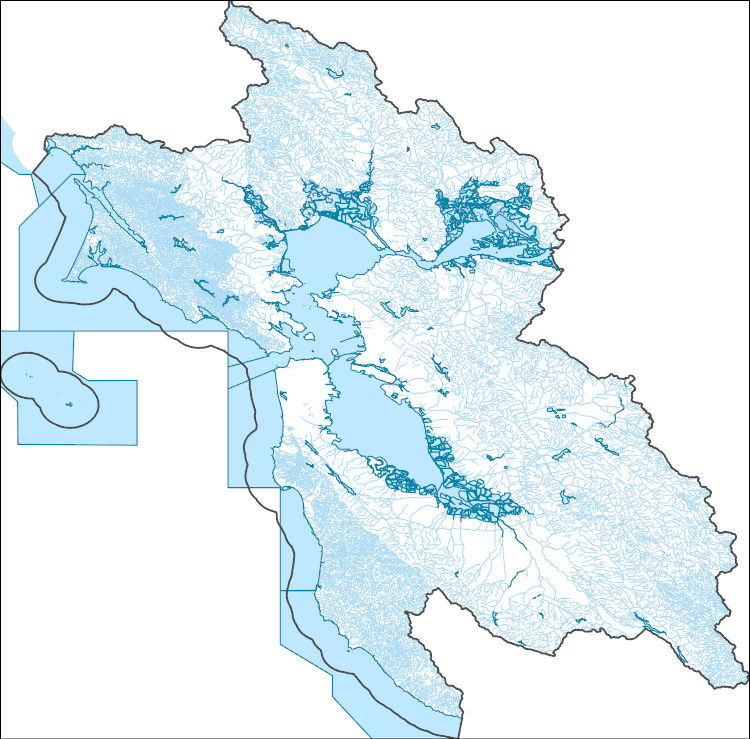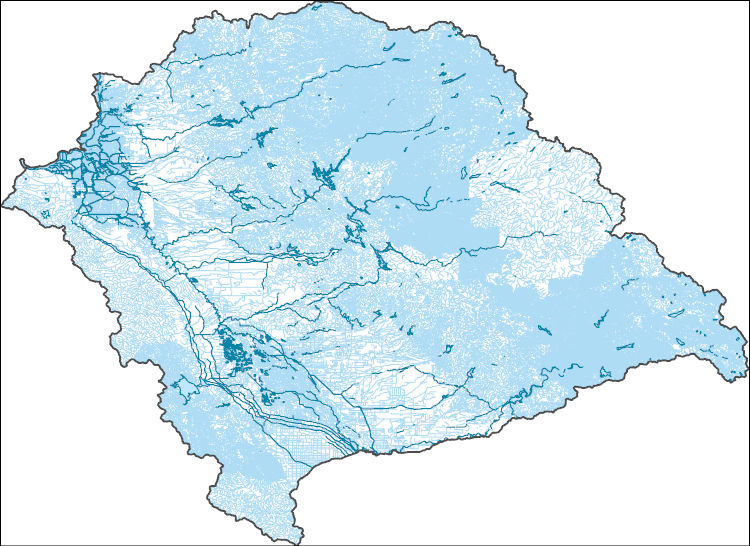Filters: Tags: california (X) > Date Range: {"choice":"day"} (X)
18 results (89ms)|
Filters
Date Types (for Date Range)
Types
Contacts
Categories Tag Types Tag Schemes |
These datasets provide early estimates of 2024 fractional cover for exotic annual grass (EAG) species and one native perennial grass species on a weekly basis from April to late June. Typically, the EAG estimates are publicly released within 7-13 days of the latest satellite observation used for that version. Each weekly release contains five fractional cover maps along with their corresponding confidence maps for: 1) a group of 16 species of EAGs, 2) cheatgrass (Bromus tectorum); 3) Field Brome (Bromus arvensis); 4) medusahead (Taeniatherum caput-medusae); and 5) Sandberg bluegrass (Poa secunda). These datasets were generated leveraging field observations from Bureau of Land Management (BLM) Assessment, Inventory,...
These datasets provide early estimates of 2024 fractional cover for exotic annual grass (EAG) species and one native perennial grass species on a weekly basis from April to late June. Typically, the EAG estimates are publicly released within 7-13 days of the latest satellite observation used for that version. Each weekly release contains five fractional cover maps along with their corresponding confidence maps for: 1) a group of 16 species of EAGs, 2) cheatgrass (Bromus tectorum); 3) Field Brome (Bromus arvensis); 4) medusahead (Taeniatherum caput-medusae); and 5) Sandberg bluegrass (Poa secunda). These datasets were generated leveraging field observations from Bureau of Land Management (BLM) Assessment, Inventory,...
This digital dataset contains groundwater level observations for 364 wells, in addition to well construction information, from 1916 to 2014 in the Central Valley, California. Groundwater level observations are used to create groundwater level contours and to calibrate the groundwater levels for the updated Central Valley Hydrologic Model (CVHM2). Groundwater level observations were collected from five sources (USGS, 2018; SLDMWA, 2018; CADWR, 2004; CRNA, 2018).
Categories: Data;
Types: Downloadable,
Map Service,
OGC WFS Layer,
OGC WMS Layer,
Shapefile;
Tags: California,
Central Valley,
Groundwater,
United States,
Water Level,
The Central Valley, and particularly the San Joaquin Valley, has a long history of land subsidence caused by groundwater development. The extensive withdrawal of groundwater from the unconsolidated deposits of the San Joaquin Valley lowered groundwater levels and caused widespread land subsidence—reaching 9 meters by 1981. More than half of the thickness of the aquifer system is composed of fine-grained sediments, including clays, silts, and sandy or silty clays that are susceptible to compaction. In an effort to aid water managers in understanding how water moves through the aquifer system, predicting water-supply scenarios, and addressing issues related to water competition, the United States Geological Survey...
Chronic Wasting Disease distribution in the United States by state and county (ver. 2.0, April 2024)
Chronic Wasting Disease (CWD) is a fatal, contagious, neuro-degenerative disease affecting multiple members of the Family Cervidae. First detected in 1967, the disease has, as of April 2024, been documented in free-ranging and/or captive cervid populations in 33 states, five Canadian provinces, the Republic of South Korea, Norway, Sweden, and Finland. The data provided here contains information on the known, available, documented distribution of CWD in the United States that is current as of the publication date. The USGS National Wildlife Health Center (NWHC) tracks changes to the known distribution of CWD in the form of a map (available on the NWHC website at https://www.usgs.gov/centers/nwhc/science/expanding-distribution-chronic-wasting-disease....
Categories: Data,
Data Release - Revised;
Types: Citation;
Tags: Alabama,
Alaska,
American Samoa,
Arizona,
Arkansas,
The Central Valley, and particularly the San Joaquin Valley, has a long history of land subsidence caused by groundwater development. The extensive withdrawal of groundwater from the unconsolidated deposits of the San Joaquin Valley lowered groundwater levels and caused widespread land subsidence—reaching 9 meters by 1981. More than half of the thickness of the aquifer system is composed of fine-grained sediments, including clays, silts, and sandy or silty clays that are susceptible to compaction. In an effort to aid water managers in understanding how water moves through the aquifer system, predicting water-supply scenarios, and addressing issues related to water competition, the United States Geological Survey...
Categories: Data;
Tags: California,
Central Valley,
Interferometric Synthetic Aperture Radar,
Subsidence,
biota
These data are monthly median observed streamflow from 32 gages in the Central Valley for comparison to the updated Central Valley Hydrologic Model (CVHM2). The locations of these gages are shown in the shape file.
Categories: Data;
Types: Downloadable,
Map Service,
OGC WFS Layer,
OGC WMS Layer,
Shapefile;
Tags: California,
Central Valley,
United States,
datasets,
stream-gage measurement,

The High Resolution National Hydrography Dataset Plus (NHDPlus HR) is an integrated set of geospatial data layers, including the best available National Hydrography Dataset (NHD), the 10-meter 3D Elevation Program Digital Elevation Model (3DEP DEM), and the National Watershed Boundary Dataset (WBD). The NHDPlus HR combines the NHD, 3DEP DEMs, and WBD to create a stream network with linear referencing, feature naming, "value added attributes" (VAAs), elevation-derived catchments, and other features for hydrologic data analysis. The stream network with linear referencing is a system of data relationships applied to hydrographic systems so that one stream reach "flows" into another and "events" can be tied to and traced...
The Central Valley, and particularly the San Joaquin Valley, has a long history of land subsidence caused by groundwater development. The extensive withdrawal of groundwater from the unconsolidated deposits of the San Joaquin Valley lowered groundwater levels and caused widespread land subsidence—reaching 9 meters by 1981. More than half of the thickness of the aquifer system is composed of fine-grained sediments, including clays, silts, and sandy or silty clays that are susceptible to compaction. In an effort to aid water managers in understanding how water moves through the aquifer system, predicting water-supply scenarios, and addressing issues related to water competition, the United States Geological Survey...
The Central Valley, and particularly the San Joaquin Valley, has a long history of land subsidence caused by groundwater development. The extensive withdrawal of groundwater from the unconsolidated deposits of the San Joaquin Valley lowered groundwater levels and caused widespread land subsidence—reaching 9 meters by 1981. More than half of the thickness of the aquifer system is composed of fine-grained sediments, including clays, silts, and sandy or silty clays that are susceptible to compaction. In an effort to aid water managers in understanding how water moves through the aquifer system, predicting water-supply scenarios, and addressing issues related to water competition, the United States Geological Survey...
The Central Valley, and particularly the San Joaquin Valley, has a long history of land subsidence caused by groundwater development. The extensive withdrawal of groundwater from the unconsolidated deposits of the San Joaquin Valley lowered groundwater levels and caused widespread land subsidence—reaching 9 meters by 1981. More than half of the thickness of the aquifer system is composed of fine-grained sediments, including clays, silts, and sandy or silty clays that are susceptible to compaction. In an effort to aid water managers in understanding how water moves through the aquifer system, predicting water-supply scenarios, and addressing issues related to water competition, the United States Geological Survey...
This digital dataset includes three sets of observational data (groundwater level, streamflow, subsidence) used to calibrate the updated Central Valley Hydrologic Model (CVHM2)
Categories: Data Release - Revised;
Tags: California,
Central Valley,
Observation,
Streamflow,
Subsidence,
An updated version has been published: Halstead, B.J., Kleeman, P.M., and Rose, J.P., 2024, Northwestern pond turtle survey data in northern California forest streams, 2021-2022: U.S. Geological Survey data release, https://doi.org/10.5066/P96GAPCC. These data are from joint visual encounter and environmental DNA (eDNA) surveys conducted for northwestern pond turtles (Actinemys marmorata) in streams on privately-owned timberlands in northern California.

This model has been superseded by an updated version of the model. The new model can be found at: https://doi.org/10.5066/P99KJ1U1, https://doi.org/10.5066/P9FTZ5RW, https://doi.org/10.5066/P9NBWLYX, https://doi.org/10.5066/P97XBULI, https://doi.org/10.5066/P980EHWV, https://doi.org/10.5066/P95XLBB5, https://doi.org/10.5066/P9ICSZWF, https://doi.org/10.5066/P96LJ01V, and https://doi.org/10.5066/P9IZRO3V. A three-dimensional groundwater flow model (MODFLOW200-FMP1_1) of the Central Valley in California was developed to aid water managers in understanding how water moves through the aquifer system, to predict water-supply scenarios, and to address issues related to water competition. The USGS Groundwater Resources...
Categories: pre-SM502.8;
Tags: California,
Central Valley,
Corcoran Clay,
Groundwater,
Groundwater Model,
These data are from joint visual encounter and environmental DNA (eDNA) surveys conducted for northwestern pond turtles (Actinemys marmorata) in streams on privately-owned timberlands in northern California.

The High Resolution National Hydrography Dataset Plus (NHDPlus HR) is an integrated set of geospatial data layers, including the best available National Hydrography Dataset (NHD), the 10-meter 3D Elevation Program Digital Elevation Model (3DEP DEM), and the National Watershed Boundary Dataset (WBD). The NHDPlus HR combines the NHD, 3DEP DEMs, and WBD to create a stream network with linear referencing, feature naming, "value added attributes" (VAAs), elevation-derived catchments, and other features for hydrologic data analysis. The stream network with linear referencing is a system of data relationships applied to hydrographic systems so that one stream reach "flows" into another and "events" can be tied to and traced...

The High Resolution National Hydrography Dataset Plus (NHDPlus HR) is an integrated set of geospatial data layers, including the best available National Hydrography Dataset (NHD), the 10-meter 3D Elevation Program Digital Elevation Model (3DEP DEM), and the National Watershed Boundary Dataset (WBD). The NHDPlus HR combines the NHD, 3DEP DEMs, and WBD to create a stream network with linear referencing, feature naming, "value added attributes" (VAAs), elevation-derived catchments, and other features for hydrologic data analysis. The stream network with linear referencing is a system of data relationships applied to hydrographic systems so that one stream reach "flows" into another and "events" can be tied to and traced...
The Central Valley covers about 20,000 square miles and is one of the most productive agricultural regions in the world. Because the valley is semi-arid, surface-water availability varies substantially. Agricultural demand for irrigation is heavily reliant on surface water and groundwater. In the last few decades, land-use changes and limitations to surface-water availability—including drought and environmental flows—have increased pumping, causing groundwater-level and groundwater-storage declines, renewed subsidence, decreased stream flows, and changes to ecosystems. As these recent trends continue, monitoring, data compilation, and modeling are critical to understanding the dynamics of groundwater use and developing...
Categories: Project;
Types: Map Service,
OGC WFS Layer,
OGC WMS Layer,
OGC WMS Service;
Tags: Agricultural,
CVHM,
CVHM2,
California,
Central Valley,
|

|